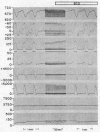Abstract
The effects of bilateral carotid artery occlusion (BCO) and carotid sinus nerve stimulation (CSNS) on left ventricular (LV) pressure (P), diameter (D), velocity of contraction (V), rate of change of pressure (dP/dt), and cardiac output were studied in conscious dogs instrumented with ultrasonic diameter gauges, miniature pressure gauges, and aortic electromagnetic flow transducers. The effects of BCO and CSNS were also studied after automatic blockade and were compared to similar alterations in pressure produced by norepinephrine, methoxamine, and nitroglycerin. When heart rate was maintained constant with atrial stimulation, BCO had little effect on ventricular contractility, increasing isolength systolic pressure (LV Piso) by 36% while isolength velocity of myocardial shortening (Viso) decreased by 12% and (dP/dt)/P fell by 8%. These effects could be explained largely by vasoconstriction, since elevating systolic pressure with methoxamine produced similar results, while norepinephrine increased Viso by 36% and (dP/dt)/P by 56%. CSNS produced directionally opposite results from BCO; it decreased Piso by 15%, Viso increased by 11%, while (dP/dt)/P remained almost constant. These effects may be explained largely by vasodilatation since reducing systolic pressure to the same level with nitroglycerin produced similar results. When peripheral vasoconstriction was minimized by phenoxybenzamine pretreatment. BCO produced a slight positive inotropic effect (Piso increased by 8%, Viso by 4%, and (dp/dt)/P by 10%), while CSNS produced a slight negative inotropic effect (Piso decreased by 3%, Viso decreased by 5%, and (dP/dt)/P by 7%).
Thus, in the normal, healthy, conscious dog, the carotid sinuses exert relatively little control of the inotropic state of the left ventricle; moreover, this small inotropic action is masked by the more powerful effects on peripheral resistance.
Full text
PDF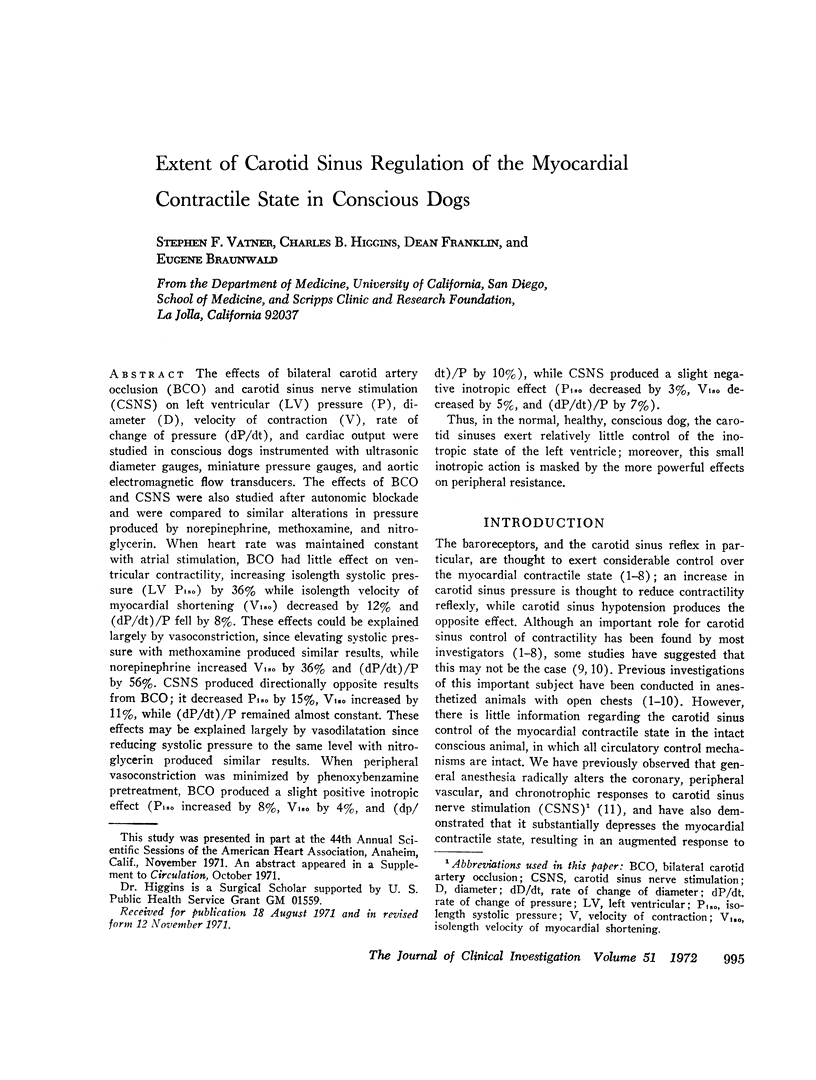
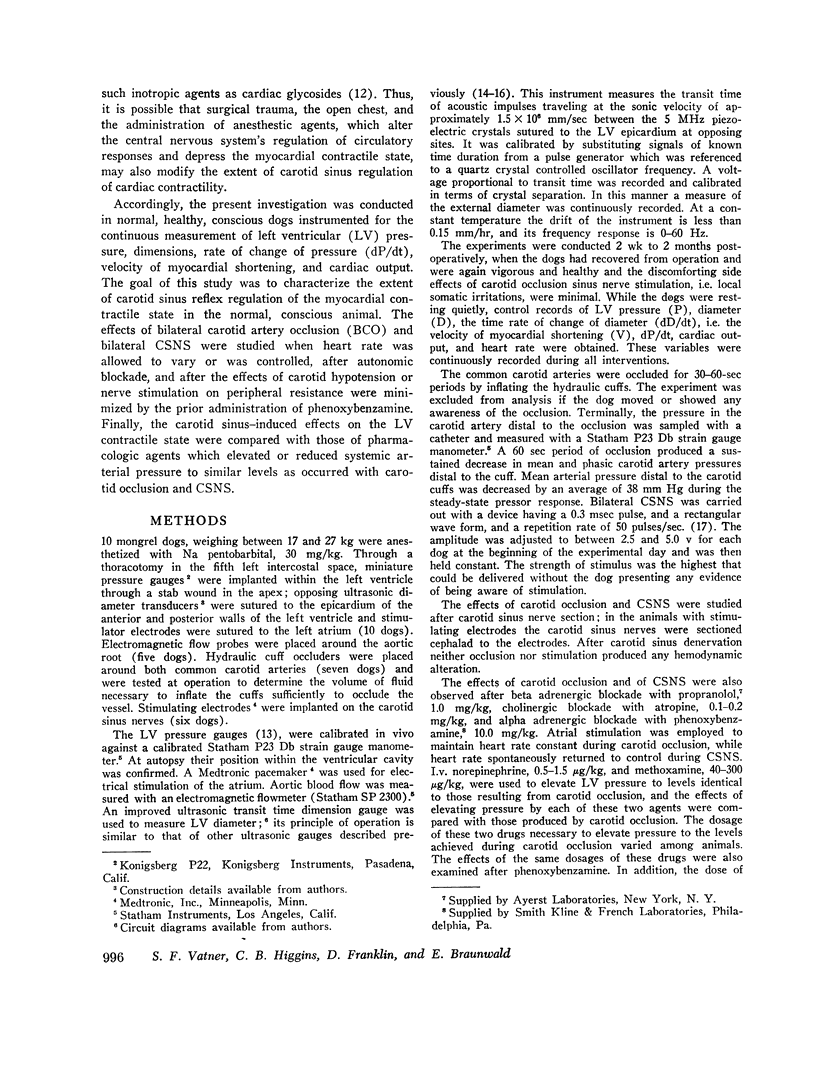
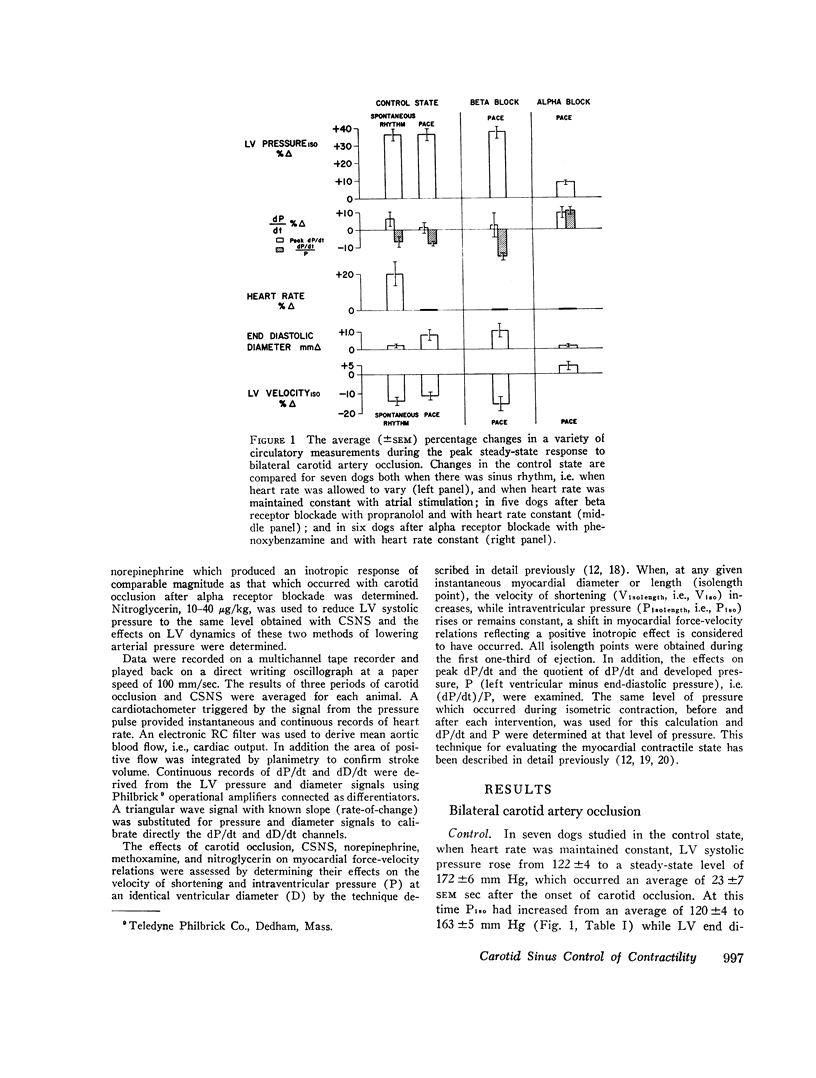
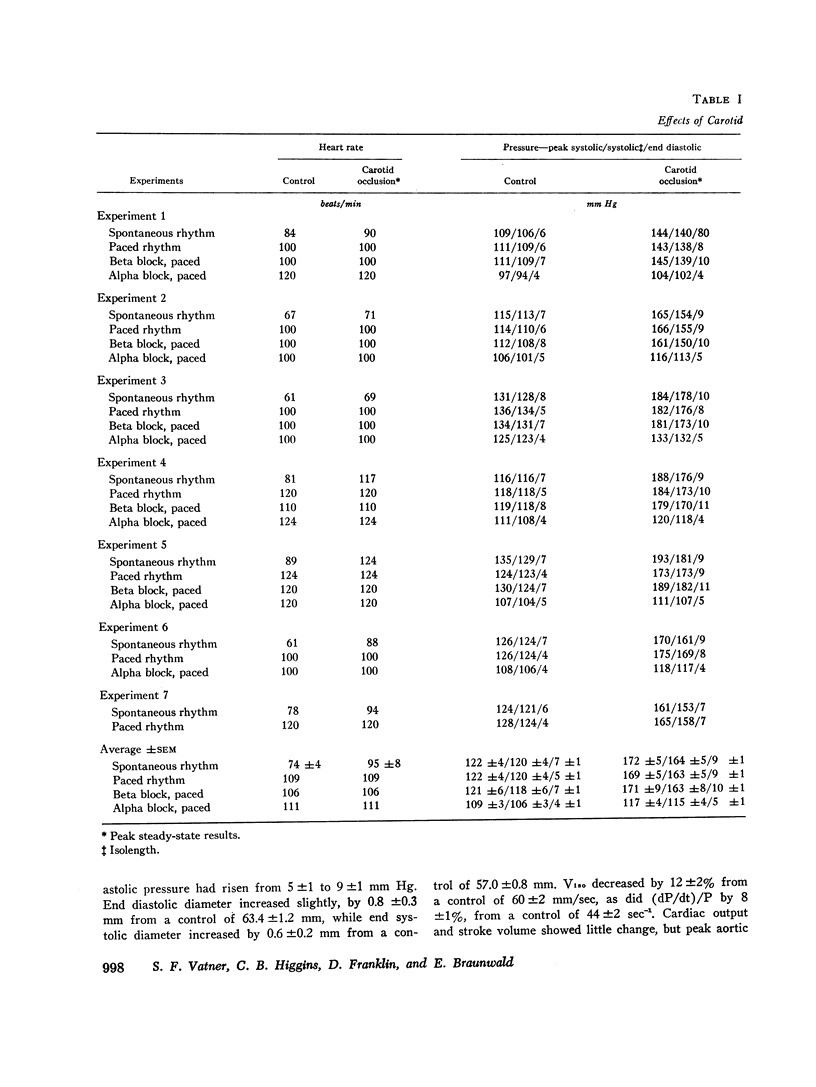
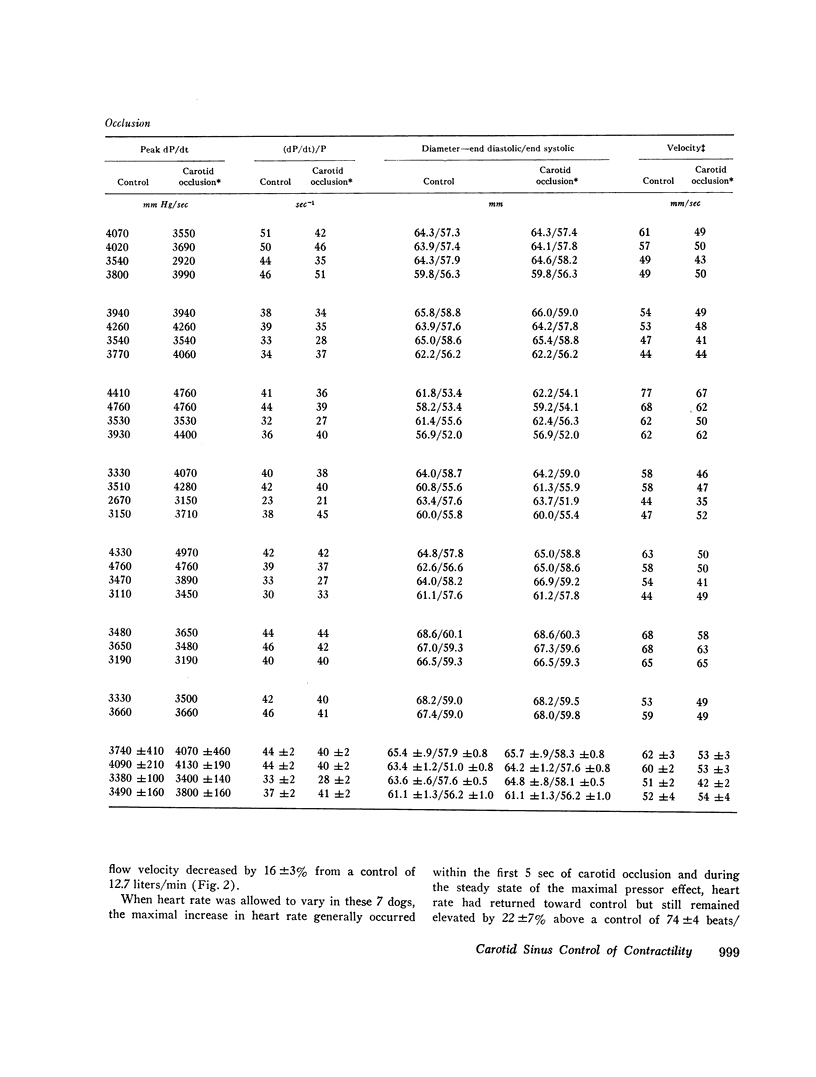
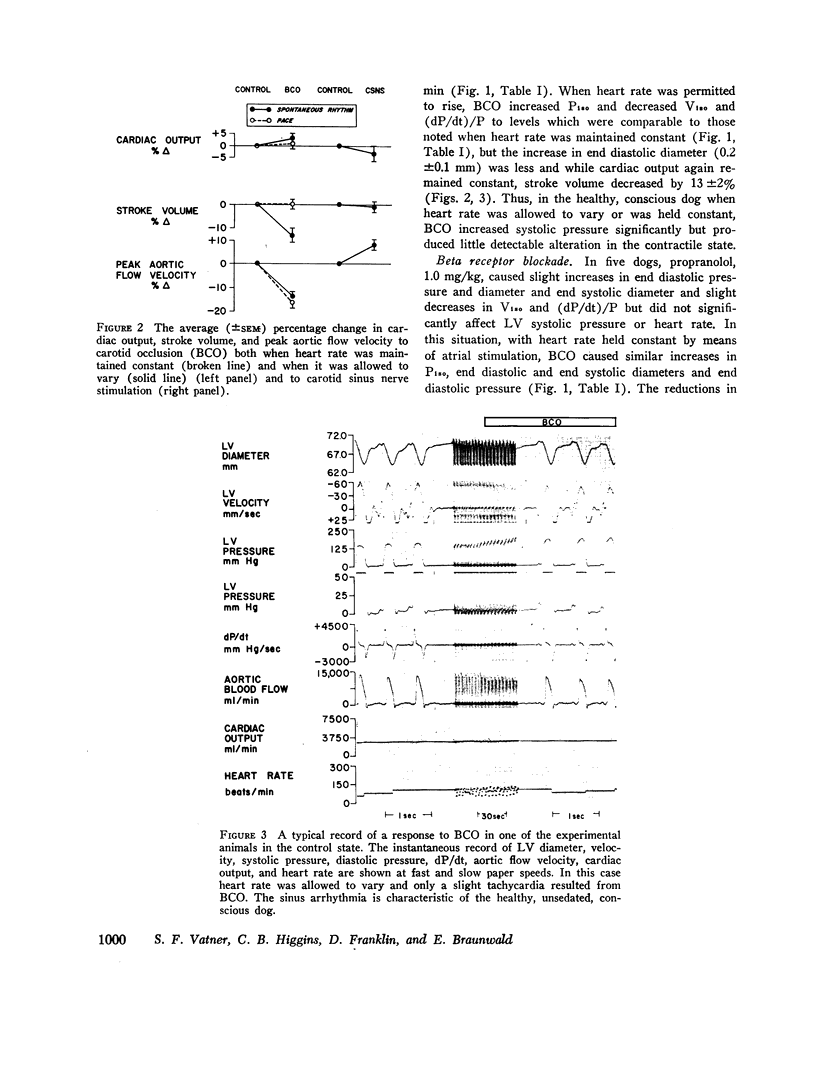
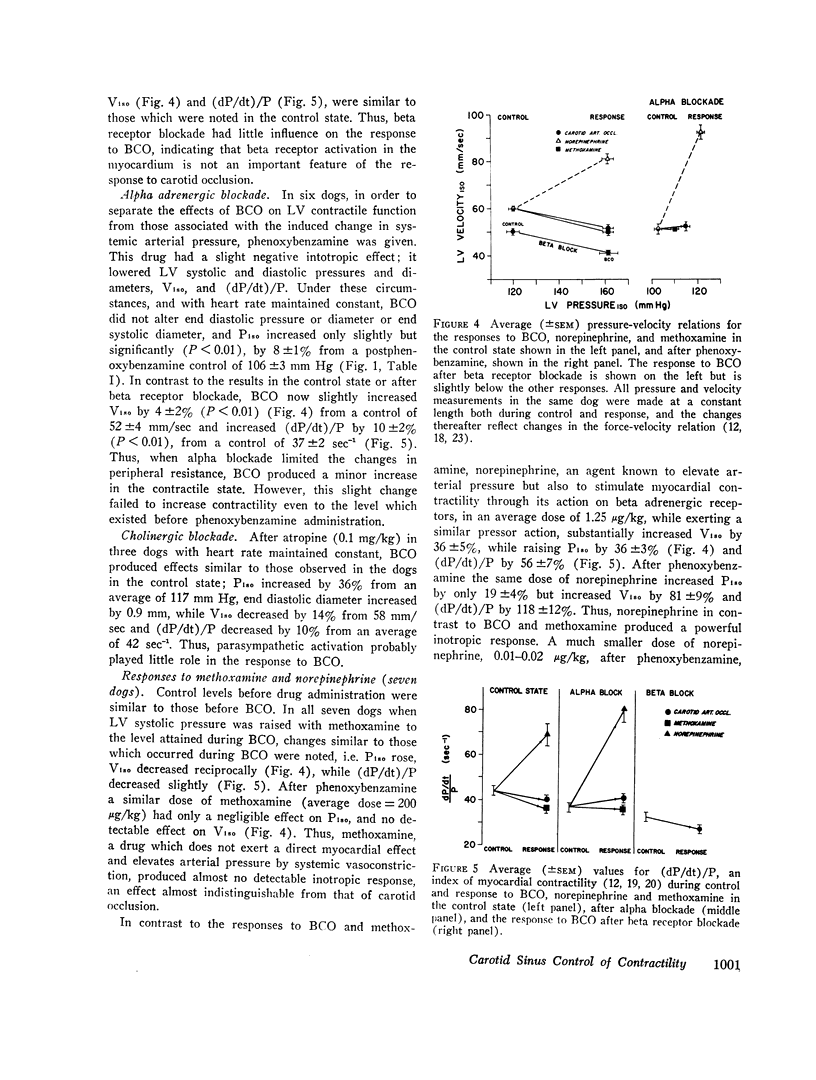
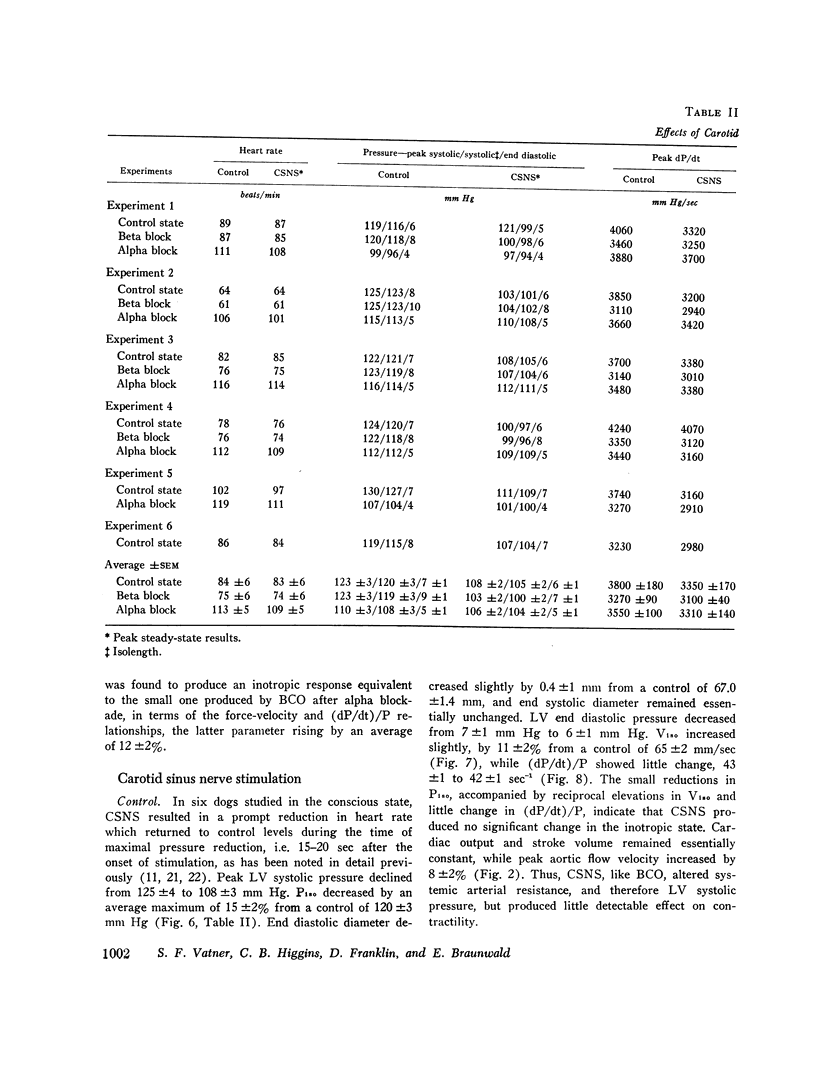
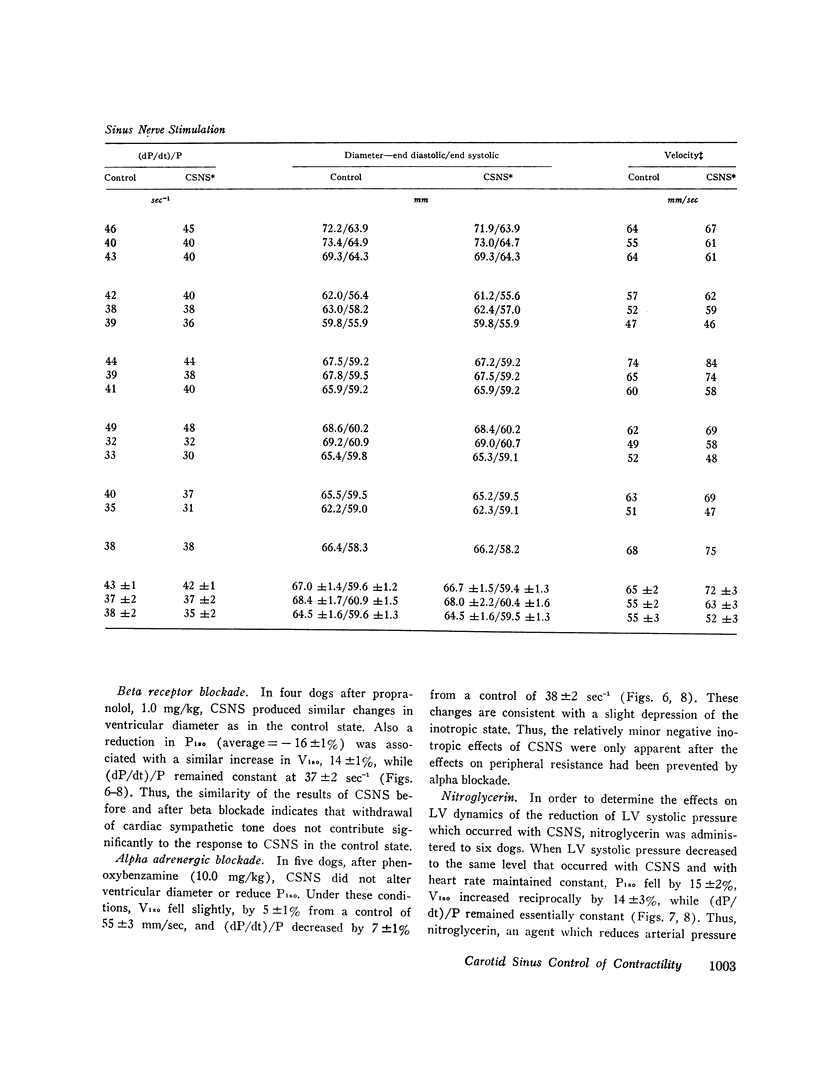
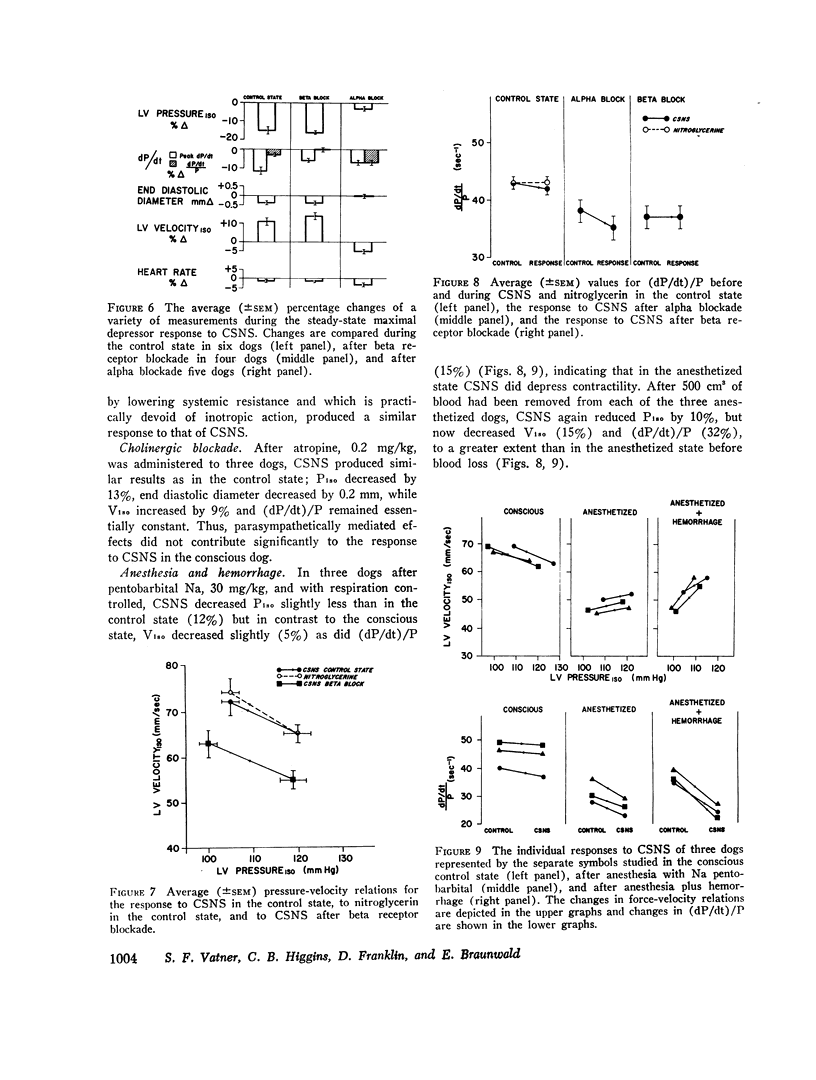
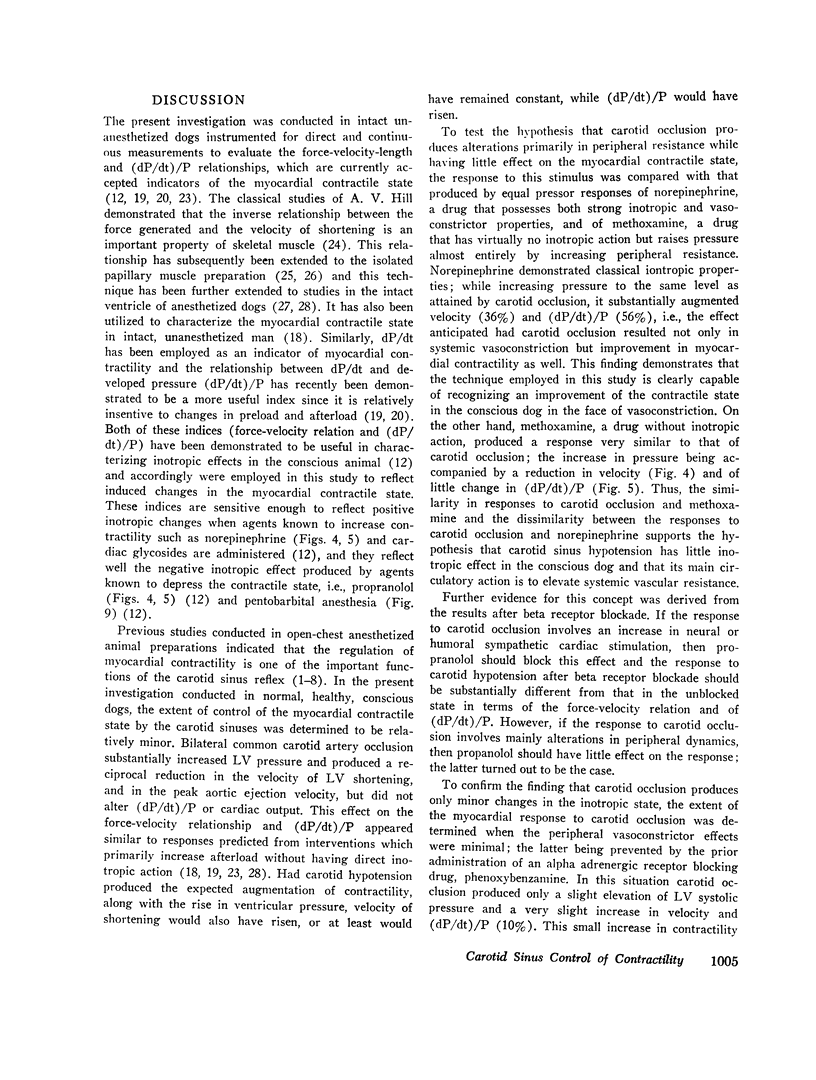
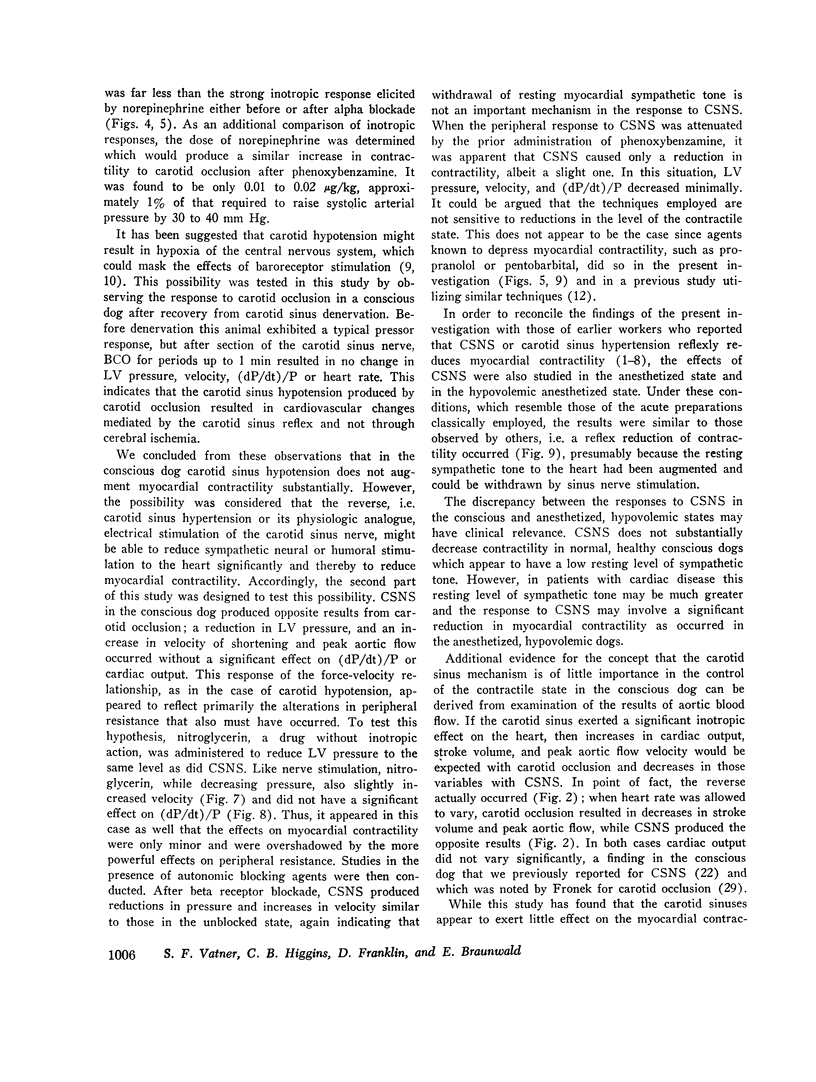
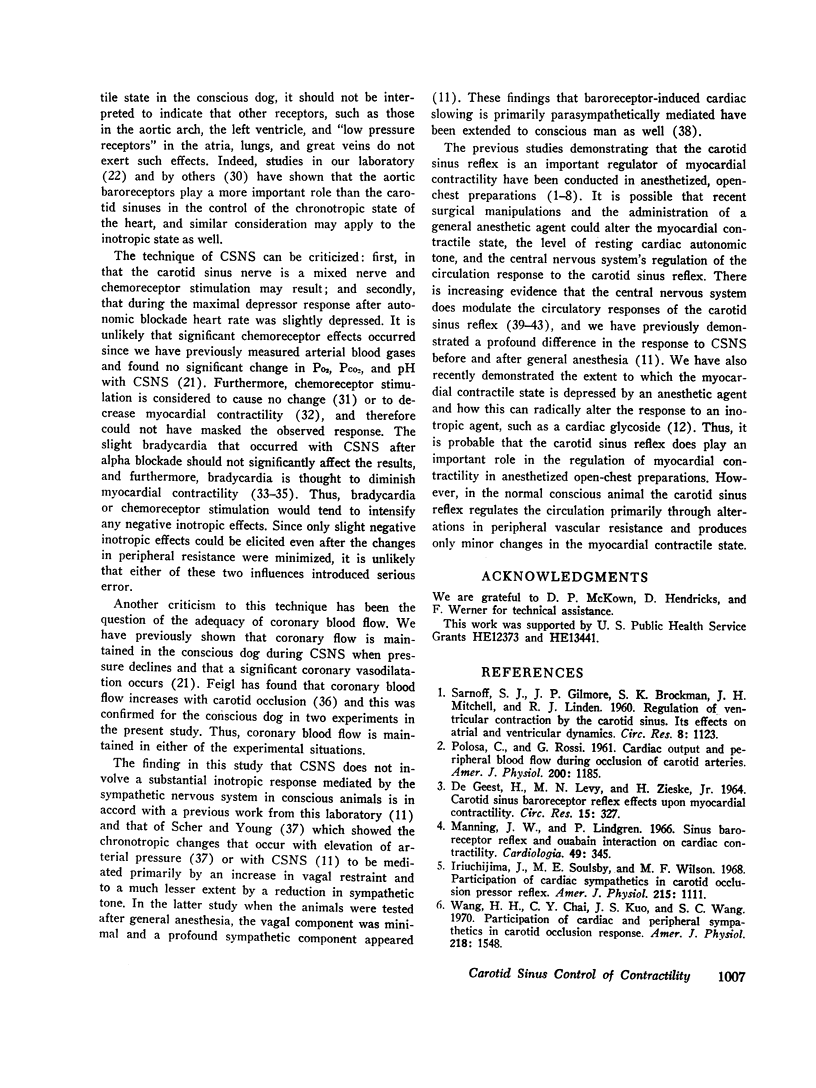
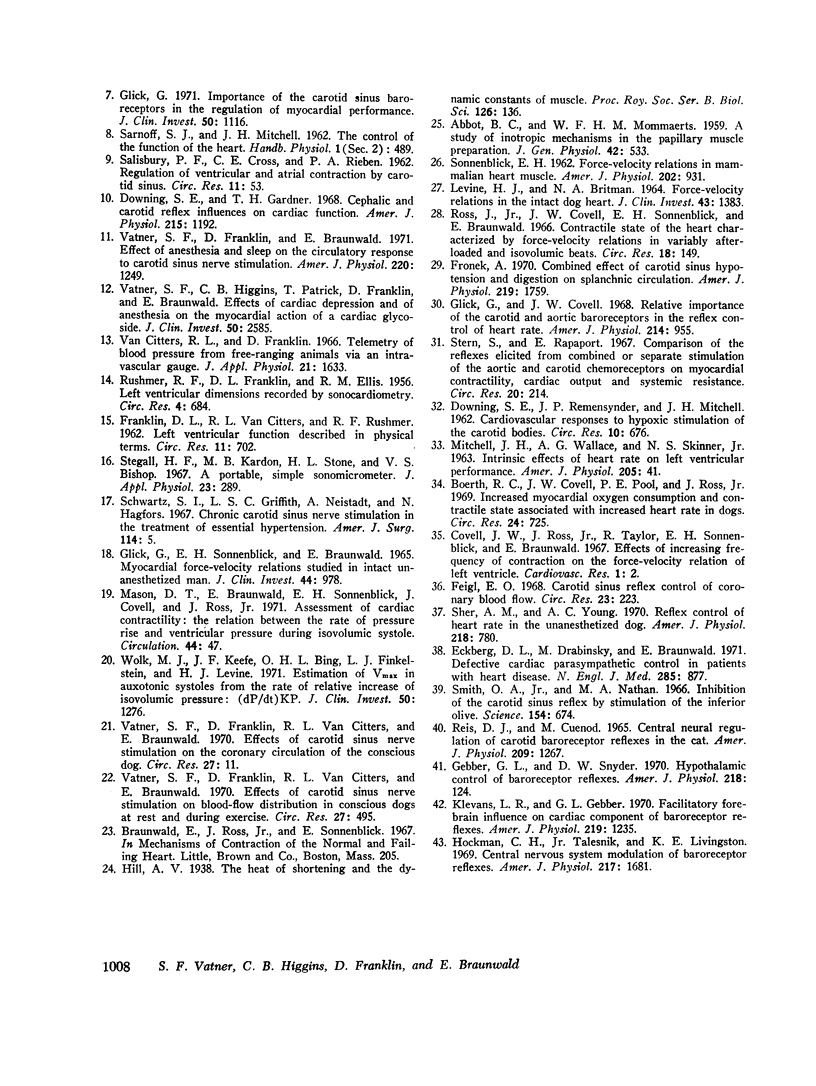
Images in this article
Selected References
These references are in PubMed. This may not be the complete list of references from this article.
- ABBOTT B. C., MOMMAERTS W. F. A study of inotropic mechanisms in the papillary muscle preparation. J Gen Physiol. 1959 Jan 20;42(3):533–551. doi: 10.1085/jgp.42.3.533. [DOI] [PMC free article] [PubMed] [Google Scholar]
- Boerth R. C., Covell J. W., Pool P. E., Ross J., Jr Increased myocardial oxygen consumption and contractile state associated with increased heart rate in dogs. Circ Res. 1969 May;24(5):725–734. doi: 10.1161/01.res.24.5.725. [DOI] [PubMed] [Google Scholar]
- Covell J. W., Ross J., Jr, Taylor R., Sonnenblick E. H., Braunwald E. Effects of increasing frequency of contraction on the force velocity relation of left ventricle. Cardiovasc Res. 1967 Jan;1(1):2–8. doi: 10.1093/cvr/1.1.2. [DOI] [PubMed] [Google Scholar]
- DEGEEST H., LEVY M. N., ZIESKE H., Jr CAROTID SINUS BARORECEPTOR REFLEX EFFECTS UPON MYOCARDIAL CONTRACTILITY. Circ Res. 1964 Oct;15:327–342. doi: 10.1161/01.res.15.4.327. [DOI] [PubMed] [Google Scholar]
- DOWNING S. E., REMENSNYDER J. P., MITCHELL J. H. Cardiovascular responses to hypoxic stimulation of the carotid bodies. Circ Res. 1962 Apr;10:676–685. doi: 10.1161/01.res.10.4.676. [DOI] [PubMed] [Google Scholar]
- Downing S. E., Gardner T. H. Cephalic and carotid reflex influences on cardiac function. Am J Physiol. 1968 Nov;215(5):1192–1199. doi: 10.1152/ajplegacy.1968.215.5.1192. [DOI] [PubMed] [Google Scholar]
- ELLIS R. M., FRANKLIN D. L., RUSHMER R. F. Left ventricular dimensions recorded by sonocardiometry. Circ Res. 1956 Nov;4(6):684–688. doi: 10.1161/01.res.4.6.684. [DOI] [PubMed] [Google Scholar]
- Eckberg D. L., Drabinsky M., Braunwald E. Defective cardiac parasympathetic control in patients with heart disease. N Engl J Med. 1971 Oct 14;285(16):877–883. doi: 10.1056/NEJM197110142851602. [DOI] [PubMed] [Google Scholar]
- FRANKLIN D. L., VAN CITTERS R. L., RUSHMER R. F. Left ventricular function described in physical terms. Circ Res. 1962 Oct;11:702–711. doi: 10.1161/01.res.11.4.702. [DOI] [PubMed] [Google Scholar]
- Feigl E. O. Carotid sinus reflex control of coronary blood flow. Circ Res. 1968 Aug;23(2):223–237. doi: 10.1161/01.res.23.2.223. [DOI] [PubMed] [Google Scholar]
- Fronek A. Combined effect of carotid sinus hypotension and digestion on splanchnic circulation. Am J Physiol. 1970 Dec;219(6):1759–1762. doi: 10.1152/ajplegacy.1970.219.6.1759. [DOI] [PubMed] [Google Scholar]
- GLICK G., SONNENBLICK E. H., BRAUNWALD E. MYOCARDIAL FORCE-VELOCITY RELATIONS STUDIED IN INTACT UNANESTHETIZED MAN. J Clin Invest. 1965 Jun;44:978–988. doi: 10.1172/JCI105215. [DOI] [PMC free article] [PubMed] [Google Scholar]
- Gebber G. L., Snyder D. W. Hypothalamic control of baroreceptor reflexes. Am J Physiol. 1970 Jan;218(1):124–131. doi: 10.1152/ajplegacy.1970.218.1.124. [DOI] [PubMed] [Google Scholar]
- Glick G., Covell J. W. Relative importance of the carotid and aortic baroreceptors in the reflex control of heart rate. Am J Physiol. 1968 May;214(5):955–961. doi: 10.1152/ajplegacy.1968.214.5.955. [DOI] [PubMed] [Google Scholar]
- Glick G. Importance of the carotid sinus baroreceptors in the regulation of myocardial performance. J Clin Invest. 1971 May;50(5):1116–1123. doi: 10.1172/JCI106583. [DOI] [PMC free article] [PubMed] [Google Scholar]
- Hockman C. H., Talesnik J., Livingston K. E. Central nervous system modulation of baroceptor reflexes. Am J Physiol. 1969 Dec;217(6):1681–1689. doi: 10.1152/ajplegacy.1969.217.6.1681. [DOI] [PubMed] [Google Scholar]
- Iriuchijima J., Soulsby M. E., Wilson M. F. Participation of cardiac sympathetics in carotid occlusion pressor reflex. Am J Physiol. 1968 Nov;215(5):1111–1114. doi: 10.1152/ajplegacy.1968.215.5.1111. [DOI] [PubMed] [Google Scholar]
- Klevans L. R., Gebber G. L. Facilitatory forebrain influence on cardiac component of baroreceptor reflexes. Am J Physiol. 1970 Nov;219(5):1235–1241. doi: 10.1152/ajplegacy.1970.219.5.1235. [DOI] [PubMed] [Google Scholar]
- LEVINE H. J., BRITMAN N. A. FORCE-VELOCITY RELATIONS IN THE INTACT DOG HEART. J Clin Invest. 1964 Jul;43:1383–1396. doi: 10.1172/JCI105014. [DOI] [PMC free article] [PubMed] [Google Scholar]
- Manning J. W., Lindgren P. Sinus baroceptor reflex and ouabain interaction on cardiac contractility. Cardiologia. 1966;49(6):345–358. doi: 10.1159/000168942. [DOI] [PubMed] [Google Scholar]
- Mason D. T., Braunwald E., Covell J. W., Sonnenblick E. H., Ross J., Jr Assessment of cardiac contractility. The relation between the rate of pressure rise and ventricular pressure during isovolumic systole. Circulation. 1971 Jul;44(1):47–58. doi: 10.1161/01.cir.44.1.47. [DOI] [PubMed] [Google Scholar]
- POLOSA C., ROSSI G. Cardiac output and peripheral blood flow during occlusion of carotid arteries. Am J Physiol. 1961 Jun;200:1185–1190. doi: 10.1152/ajplegacy.1961.200.6.1185. [DOI] [PubMed] [Google Scholar]
- Reis D. J., Cuénod M. Central neural regulation of carotid baroreceptor reflexes in the cat. Am J Physiol. 1965 Dec;209(6):1267–1277. doi: 10.1152/ajplegacy.1965.209.6.1267. [DOI] [PubMed] [Google Scholar]
- SALISBURY P. F., CROSS C. E., RIEBEN P. A. Regulation of ventricular and atrial contraction by carotid sinus. Circ Res. 1962 Jul;11:53–62. [PubMed] [Google Scholar]
- SARNOFF S. J., GILMORE J. P., BROCKMAN S. K., MITCHELL J. H., LINDEN R. J. Regulation of ventricular contraction by the carotid sinus. Its effect on atrial and ventricular dynamics. Circ Res. 1960 Sep;8:1123–1136. doi: 10.1161/01.res.8.5.1123. [DOI] [PubMed] [Google Scholar]
- SONNENBLICK E. H. Force-velocity relations in mammalian heart muscle. Am J Physiol. 1962 May;202:931–939. doi: 10.1152/ajplegacy.1962.202.5.931. [DOI] [PubMed] [Google Scholar]
- Scher A. M., Young A. C. Reflex control of heart rate in the unanesthetized dog. Am J Physiol. 1970 Mar;218(3):780–789. doi: 10.1152/ajplegacy.1970.218.3.780. [DOI] [PubMed] [Google Scholar]
- Schwartz S. I., Griffith L. S., Neistadt A., Hagfors N. Chronic carotid sinus nerve stimulation in the treatment of essential hypertension. Am J Surg. 1967 Jul;114(1):5–15. doi: 10.1016/0002-9610(67)90034-7. [DOI] [PubMed] [Google Scholar]
- Smith O. A., Jr, Nathan M. A. Inhibition of the carotid sinus reflex by stimulation of the inferior olive. Science. 1966 Nov 4;154(3749):674–675. doi: 10.1126/science.154.3749.674. [DOI] [PubMed] [Google Scholar]
- Stegall H. F., Kardon M. B., Stone H. L., Bishop V. S. A portable, simple sonomicrometer. J Appl Physiol. 1967 Aug;23(2):289–293. doi: 10.1152/jappl.1967.23.2.289. [DOI] [PubMed] [Google Scholar]
- Stern S., Rapaport E. Comparison of the reflexes elicited from combined or separate stimulation of the aortic and carotid chemoreceptors on myocardial contractility, cardiac output and systemic resistance. Circ Res. 1967 Feb;20(2):214–227. doi: 10.1161/01.res.20.2.214. [DOI] [PubMed] [Google Scholar]
- Van Citters R. L., Franklin D. L. Telemetry of blood pressure in free-ranging animals via an intravascular gauge. J Appl Physiol. 1966 Sep;21(5):1633–1636. doi: 10.1152/jappl.1966.21.5.1633. [DOI] [PubMed] [Google Scholar]
- Vatner S. F., Franklin D., Braunwald E. Effects of anesthesia and sleep on circulatory response to carotid sinus nerve stimulation. Am J Physiol. 1971 May;220(5):1249–1255. doi: 10.1152/ajplegacy.1971.220.5.1249. [DOI] [PubMed] [Google Scholar]
- Vatner S. F., Franklin D., Van Citters R. L., Braunwald E. Effects of carotid sinus nerve stimulation on blood-flow distribution in conscious dogs at rest and during exercise. Circ Res. 1970 Oct;27(4):495–503. doi: 10.1161/01.res.27.4.495. [DOI] [PubMed] [Google Scholar]
- Vatner S. F., Franklin D., Van Citters R. L., Braunwald E. Effects of carotid sinus nerve stimulation on the coronary circulation of the conscious dog. Circ Res. 1970 Jul;27(1):11–21. doi: 10.1161/01.res.27.1.11. [DOI] [PubMed] [Google Scholar]
- Wang H. H., Chai C. Y., Kuo J. S., Wang S. C. Participation of cardiac and peripheral sympathetics in carotid occlusion response. Am J Physiol. 1970 Jun;218(6):1548–1554. doi: 10.1152/ajplegacy.1970.218.6.1548. [DOI] [PubMed] [Google Scholar]
- Wolk M. J., Keefe J. F., Bing O. H., Finkelstein L. J., Levine H. J. Estimation of Vmax in auxotonic systoles from the rate of relative increase of isovolumic pressure: (dP-dt)kP. J Clin Invest. 1971 Jun;50(6):1276–1285. doi: 10.1172/JCI106606. [DOI] [PMC free article] [PubMed] [Google Scholar]



